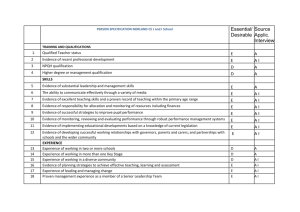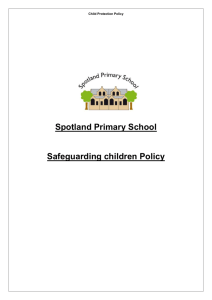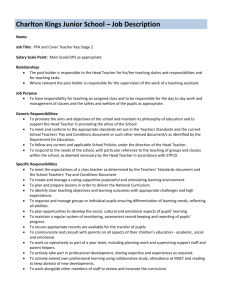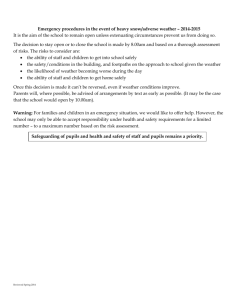Child Protection Policy
advertisement
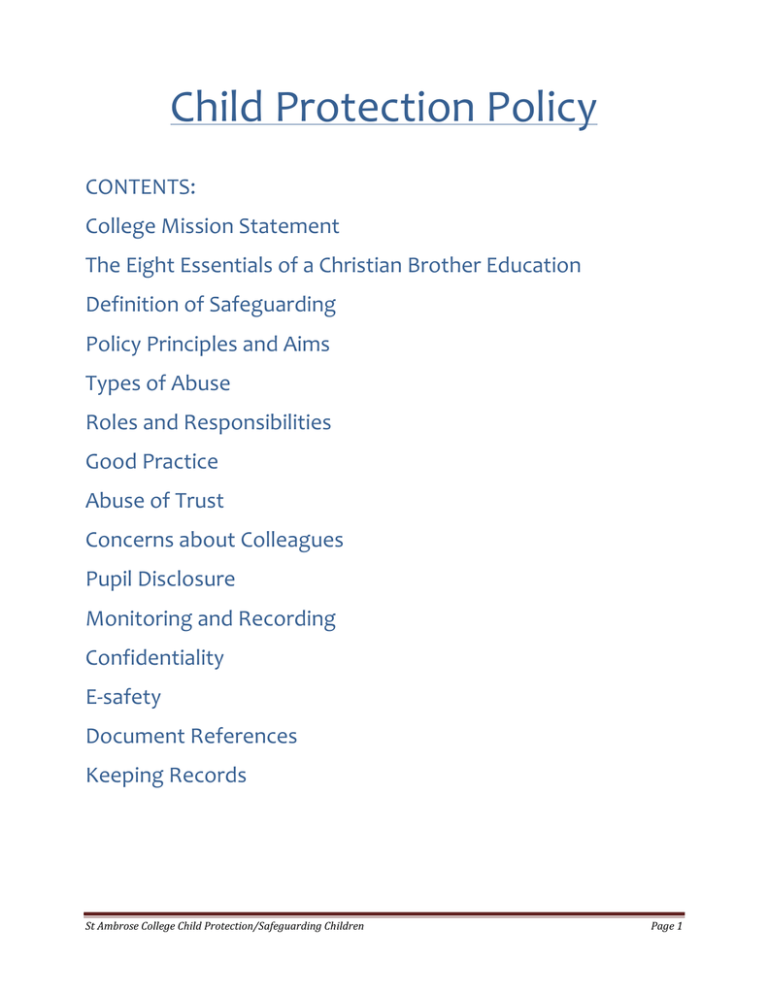
Child Protection Policy CONTENTS: College Mission Statement The Eight Essentials of a Christian Brother Education Definition of Safeguarding Policy Principles and Aims Types of Abuse Roles and Responsibilities Good Practice Abuse of Trust Concerns about Colleagues Pupil Disclosure Monitoring and Recording Confidentiality E-safety Document References Keeping Records St Ambrose College Child Protection/Safeguarding Children Page 1 College Mission statement In this College we strive together to make real in our lives and in the world the values of the Gospel of Jesus Christ. The aim of the school is to foster a community in which each member of that community is afforded every opportunity to realise their full potential. There is no discrimination (positive or negative) towards any group within the school. All members of the school community have an opportunity to guide the progress of the school. In order to achieve this aim we Provide a well-ordered caring environment where self-discipline is emphasised and pupils are enabled to take responsibility for their own actions following a reasoned set of Christian values and principles. Demand of the pupils the highest possible standards while supporting them with a system of pastoral care that promotes respect for all in the community. We therefore value highly good manners, courtesy and fairness. Offer support and guidance for all the pupils as they take advantage of the wide opportunities offered to them within the College enabling them to make full use of their talents and so contribute to the good of the whole school. Seek to develop the College as a vibrant Christian community where pupils will learn to integrate their Catholic faith and culture "seeking first the kingdom of God" and enabling them to be "ambassadors of Christ". We aim to do this in a spirit of hope and happiness following the example of Blessed Edmund Rice under the guidance of the Holy Spirit and the patronage of Our Lady, Help of all Christians. St Ambrose College Child Protection/Safeguarding Children Page 2 Eight Essentials of Christian Brother Education Evangelizing the Modern World: Participating in the mission of the Catholic Church by bringing the Good News of Christ in all aspects of the life of the school community, and in the dialogue with youth and contemporary culture, thus fulfilling the specific calling of the Congregation of the Christian Brothers: "the Evangelization of youth through the Apostolate of Christian Education " Promoting the Spiritual in Gospel: Nurturing a living faith, fostering Christian spirituality, educating in Gospel-based values, living beyond the material dimension. Building a Christian Community: Growing as a school community in which the equality of care and relationships is Christ-inspired, based on mutual respect, self-sacrifice, and fully human dignity. Compassion for those in Need: Showing, in the spirit of Blessed Edmund Rice, particular love and concern towards the weakest members of the school community and reaching out beyond the school in compassion and practical action for the poor and marginalized both locally and internationally. Concern for the Whole Person: Centering the curriculum, opportunities and challenges of the school on the balanced and integrated development of its students and staff across all the positive dimensions of personal growth - religious, moral, intellectual, cultural, physical and social. Striving for Excellence: Encouraging each individual to use his or her talents to the full, whether academic, cultural, or physical, and pursuing the highest standards in all aspects of learning, teaching, and extra-curricular endeavour. Education as a Christian Calling: Valuing and enabling the role and vocation of Christian teachers and support staff as a calling from God and a sharing in the Church’s mission. Education for Justice: Inspiring the minds and hearts of the young to care for all God’s creation and build a more just society, God’s kingdom on earth, and developing in them the talents for active citizenship and transformational leadership. St Ambrose College Child Protection/Safeguarding Children Page 3 COMPASSION FOR THOSE IN NEED Showing, in the spirit of Blessed Edmund Rice, particular love and concern towards the weakest members of the school community and reaching out beyond the school in compassion and practical action for the poor and marginalized both locally and internationally. Introduction All staff share an objective of keeping children and young people safe, and have a duty “to safeguard and promote the welfare of children” in accordance with sections 175 /157 of the Education Act 2002. [See appendix 1] We recognize our legal duty to safeguard all pupils in accordance with the statutory guidance “Safeguarding Children and Safer Recruitment in Education” (DCSF 2006) [See appendix 2] Definition of Safeguarding Protecting children and young people from maltreatment Preventing impairment of children and young people’s health or development Ensuring that children and young people are growing up in circumstances consistent with the provision of safe effective care Undertaking that role so as to enable those children and young people to have optimum life chances and to enter adulthood successfully Policy Principles The welfare of children is paramount All children regardless of age, gender, ability, culture, race, language, religion, sexual identity, have equal rights to protection All staff have a equal responsibility to act on any suspicion or disclosure that may suggest a child as at risk of harm Pupils and staff involved in Child Protection issues will receive appropriate support St Ambrose College Child Protection/Safeguarding Children Page 4 Policy aims To provide all staff with the necessary information to enable them to meet their child protection responsibilities To ensure good practice To demonstrate the school’s commitment with regards to child protection to pupils, parents and other partners Categories of abuse Physical Physical abuse may involve hitting, shaking, throwing, poisoning, burning, drowning, suffocating or otherwise causing physical harm to a child. Physical harm may also be caused when a parent/carer fabricates the symptom, or deliberately induces illness in a child [See appendix 3] Sexual Sexual abuse involves forcing or enticing a child to take part in sexual activities, including prostitution, whether or not the child is aware of what is happening. They may also include non-contact activities such as involving children in looking at or in the production of pornographic material or watching sexual activities or encouraging children to behave in sexually inappropriate ways. Neglect Neglect is the persistent failure to meet a child’s basic physical and/or psychological needs, likely to result in serious impairment of the child’s health or development. Emotional Emotional abuse is the persistent emotional maltreatment of a child such to cause severe adverse effects on the child’s emotional health. Domestic abuse 1 2 Any incident or pattern of incidents of controlling , coercive or threatening behaviour, violence or abuse between those aged 16 or over who are, or have, been intimate partners or family members regardless of gender or sexuality. This can encompass, but is not limited to, to following types of abuse: Psychological; Physical; Sexual; Financial; Emotional. St Ambrose College Child Protection/Safeguarding Children Page 5 1 Controlling behaviour is a range of acts designed to make a person subordinate and/or dependent by isolating them from sources of support, exploiting their resources and capacities for personal gain, depriving them of the means needed for independence, resistance and escape, and regulating their everyday behaviour. 2 Coercive behaviour is an act or a pattern of acts of assault, threats, humiliation and intimidation or other abuse that is used to harm, punish or frighten their victim. Bullying This must be treated very seriously since it causes extreme anxiety and distress; it is not a separate category of abuse. This policy applies to all staff, governors and volunteers working in the school. We recognize that midday assistants, site managers or administrative staff could be the first point of disclosure for pupils. There are five main elements to our policy: 1. To ensure we practise safe recruitment in checking the suitability of staff and volunteers to work with children. 2. To raise awareness of safeguarding issues and to equip children with the skills needed to keep themselves safe. 3. To develop and then implement procedures for identifying and reporting cases, or suspected cases, of abuse. 4. To support pupils who have been abused in accordance with their agreed Child Protection Plan. 5. To establish and maintain a safe environment in which children can learn and develop. St Ambrose College Child Protection/Safeguarding Children Page 6 Child Protection Policy - St Ambrose College We recognize that because of the day to day contact with children, school staff are well placed to observe the outward signs of abuse. The school will therefore: o Establish and maintain an environment where children feel secure, are encouraged to talk, and are listened to. o Ensure children know that there are adults in the school whom they can approach if they are worried. o Include opportunities in the PSHE curriculum for children to develop the skills they need to recognize and stay safe from abuse. o We follow the procedures set out by Trafford Safeguarding Children Board (TSCB) www.tscb.org.uk o We will take account of guidance issued by the Department for Education. o Ensure every member of staff, volunteer and governor knows the name of the designated Senior Person responsible for child protection, their deputy and their roles and responsibilities. o Ensure all staff and volunteers understand their responsibilities in being alert to the signs/indicators of abuse and understand their responsibility for referring any concerns to the designated teacher responsible for child protection. o Ensure that parents have an understanding of the responsibility placed on the school and staff for child protection by setting out its obligations in the school prospectus. o Notify social services if there is an unexplained absence of more than two days of a pupil who is subject to a Child Protection Plan. St Ambrose College Child Protection/Safeguarding Children Page 7 o Develop effective links with relevant agencies and co-operate as required with their enquiries regarding child protection matters including attendance at case conferences. o Keep written records of concerns about children, even where there is no need to refer the matter immediately. Roles and Responsibilities The designated senior person for Child Protection is the Headmaster The deputy designated person is Mr. Arthur The nominated Child Protection Governor is Mrs Kerr Responsibilities of the designated senior person (DSP): (or deputy) o To be appropriately trained, attending inter-agency training every two years o Ensure all staff know who the designated senior person(s) are o To keep a record of staff attendance at Child protection training o To be fully conversant with the policies and procedures of the school and of the Trafford Safeguarding Children Bureau (TSCB) o Have a working knowledge of how TSCB operates and the conduct of a child protection conference and plan o Refer cases of suspected abuse or allegations to the Multi-Agency Referral and Assessment Team (MARAT) o Act as a source of support, advice and expertise within the school o To be able to recognize the signs/indicators of abuse and when it is appropriate to make a referral or seek further advice o Ensure all teaching and non-teaching staff staff (especially new or parttime staff) are aware of or have access to, and understand the school’s Child Protection Policy and their role within the policy o To ensure all staff have signed to confirm that they have received or read a copy of the school’s Child Protection Policy o Ensure all staff have induction training, updated every three years, and are able to recognize and report any concerns as soon as they arise St Ambrose College Child Protection/Safeguarding Children Page 8 o To liaise with the Children and Young People Service (CYPS) and other agencies through a multi-agency approach where there are concerns about a pupil o Liaise with the nominated Governor (and Headteacher, where the DSP role is not already carried out by the Headteacher) o Ensure all records are kept securely in a locked location and separate from the main pupil file. o Follow procedures where an allegation is made against a member of staff or volunteer. o Ensure safe recruitment practices are always followed. GOOD PRACTICE We recognize that children who are abused or witness violence may find it difficult to develop a sense of self worth. They may feel helplessness, humiliation and some sense of blame. The school may be the only stable, secure and predictable element in the lives of children at risk. When at school their behaviour may be challenging and defiant or they may be withdrawn. The school will endeavour to support the pupil through: o The content of the curriculum; o The College ethos, which promotes a positive, supportive and secure environment and gives pupils a sense of being valued; o The College behaviour policy, which is aimed at supporting vulnerable pupils in the school; o The College will ensure that the pupil knows that some behaviour is unacceptable but they are valued and not to be blamed for any abuse which has occurred o Liaison with other agencies that support the pupil such as social services, Child and Adult Mental Health Service, (CAMHS) Education Welfare service and Educational Psychology service; St Ambrose College Child Protection/Safeguarding Children Page 9 o Ensuring that, where a pupil on the Child Protection Register leaves the school their information is transferred to the new school immediately and that the child's social worker is informed. GUIDANCE FOR STAFF: We recognize that staff have a particular responsibility to care for and look after all pupils and that through poor practice staff may deliberately or unintentionally put themselves or pupils at risk. All staff working for the school will therefore: o Treat all pupils fairly and with respect, abiding to other relevant policies. o Only communicate with pupils and parents via the formal methods available via the office or use school email addresses, VLE or school mobile phones and not provide pupils or parents with personal contact details. o Only provide transport for pupils on organized school trips, with the prior agreement of parents and only provide transport in school minibuses. o Always ensure that classroom doors are not locked, blocked or blacked out while the rooms are occupied. o Never be alone with one pupil in an isolated environment. o Report any indications (verbal, written or physical) that suggest a pupil may be infatuated with a member of staff. o Always approve any planned social contact with senior colleagues, for example when it is part of a reward scheme or pastoral care programme. o Advise senior management of any regular social contact they have with a pupil which may give rise to concern. o Report and record any situation, which they feel, might compromise the school or their own professional standing. o Avoid meetings with students in remote, secluded areas of College. St Ambrose College Child Protection/Safeguarding Children Page 10 o Recognize that failure to adhere to these and other sensible and professional methods of working with pupils may lead to disciplinary action. FURTHER INFORMATION AND GUIDANCE Abuse of Trust All staff at school must be aware that inappropriate behaviour towards a pupil is unacceptable; staff conduct towards pupils must be beyond reproach. It is an offence for a person over the age of eighteen to have sexual relations with a person under the age of eighteen where that person is in a position of trust, even if the relationship is consensual. This means that any sexual activity between a member of the school staff and a pupil is a criminal offence even if that pupil is over eighteen years old. Children who may be vulnerable To ensure all children have equal protection we will give special consideration to children who are o Disabled or have special educational needs o Living in a domestic abuse situation o Affected by parental substance misuse o Asylum seekers o Living away from home o Vulnerable to being bullied, or engaging in bullying o Living in temporary accommodation o Living transient lifestyles o Living in chaotic and unsupportive home situations o Vulnerable to discrimination on the grounds of race, ethnicity, religion or sexuality St Ambrose College Child Protection/Safeguarding Children Page 11 o Involved directly or indirectly in child prostitution or child trafficking o Do not have English as a first language Concerns about a Colleague All concerns of poor practice or possible child abuse by colleagues should be reported to the Headteacher. Concerns about the Headteacher should be reported to the Chair of Governors. Taking Action o All staff must take action if they have a concern about a child o In an emergency, take action to help the child o Report your concern to the designated senior person as soon as possible, at least by the end of the day o Do not start your own investigation o Share information on a “need-to-know” basis only – do not discuss the issue with colleagues, friends or family o Record your concerns accurately and factually o Seek support if you are distressed. If a pupil discloses abuse Remember that it takes a lot of courage for a child to disclose that they are being abused. If a pupil talks to a member of staff about any risks to their safety or well-being the member of staff must let the pupil know that they must pass on the information as staff are not allowed to keep secrets with children. Whilst individual indicators may not, in isolation, provide conclusive evidence of abuse, they should be viewed as part of an overall picture with each piece of information helping the designated person to decide how to proceed. It is very important that staff report their concerns – they do not need ‘absolute proof’ that a child is at risk. St Ambrose College Child Protection/Safeguarding Children Page 12 Monitoring and Recording o Staff must ensure notes are taken objectively and factually, confirming the details with the pupil at the end of the conversation o Take what the child says seriously o Do not ask leading questions o Make a careful note of exactly what the child says as far as is possible o Note the behaviour and emotional state of the child o Note any injuries, marks to the body, noting date, location and explanation for the injury o Note any relevant attendance information o Note the child’s appearance and dress o Include dates, times and events o Sign and date the record before passing it to the designated senior person, do NOT make a copy of it. Procedure for staff to register concerns with the designated person This best done in person by the end of the day during which concerns were raised. A written statement of your concern would be very helpful with any notes of a conversation you may have had with a pupil, signed and dated by yourself. The designated senior person will make notes and record your concerns, having clarified what the nature of the concern is. If the designated senior person and the deputy designated person are unavailable, an e-mail may be sent to both such people using your school e-mail address; the designated senior person will follow this up at the first opportunity on the following day, proceeding in person, as above. St Ambrose College Child Protection/Safeguarding Children Page 13 Staff Training New staff and Governors will receive training during their induction. All staff, including the Headteacher (unless the Headteacher is the DSP) and Governors will receive training that is updated at least every three years and the DSP will receive training updated every two years. Supply staff and other visiting staff will be given safeguarding information. Referral to Social Care The Designated Senior Person will make a referral to, or seek advice from, the Multi-Agency and Assessment Team (MARAT) [0161 912 5125] if it is believed that a pupil is suffering from or at risk of suffering, significant harm. The pupil (subject to age and understanding) and the parents, will be told that a referral is being made, unless to do so would increase the risk to the child. In the case of suspected sexual abuse advice would first be sought from MARAT. Confidentiality All staff must understand that Child Protection issues warrant a high level of confidentiality, not only out of respect for the pupil and staff involved but also to ensure that any information released into the public domain within or outside of school, does not compromise the evidence received. Staff should only discuss their concerns with the DSP, Headteacher or Chair of Governors (depending on who is the subject of the concern). That person will then decide who else needs to have the information and they will then disseminate it on a ‘need-to-know’ basis. St Ambrose College Child Protection/Safeguarding Children Page 14 E-Safety Computers and mobile phones are part of communication and education; some adults and young people may, however, use technology to harm children. The harm might range from sending hurtful or abusive texts and / or e-mails, to enticing children to engage in sexually harmful conversations online, webcam filming, photography or face-to-face meetings. Staff need to be alert to such dangers. This policy will be reviewed annually. In the event of a child abuse incident the internal procedures will be reviewed to assess their effectiveness. A written record will be kept of this review. References Safeguarding children and Safer Recruitment in Education (DfES 2oo6) Working Together to Safeguard Children (DfE 2012) Trafford Safeguarding Children Board Procedures (2009) www.tscb.org.uk What to do if you are worried a child is being abused (DfES 2006) Information sharing: guidance for practitioners and managers (2009) Guidance for safer working practice for the protection of children and staff in education settings (2009) St Ambrose College Child Protection/Safeguarding Children Page 15 Appendix 1 Education Act 2002 175 Duties of LEAs and governing bodies in relation to welfare of children(1)A local education authority shall make arrangements for ensuring that the functions conferred on them in their capacity as a local education authority are exercised with a view to safeguarding and promoting the welfare of children. (2)The governing body of a maintained school shall make arrangements for ensuring that their functions relating to the conduct of the school are exercised with a view to safeguarding and promoting the welfare of children who are pupils at the school. (3)The governing body of an institution within the further education sector shall make arrangements for ensuring that their functions relating to the conduct of the institution are exercised with a view to safeguarding and promoting the welfare of children receiving education or training at the institution. (4)An authority or body mentioned in any of subsections (1) to (3) shall, in considering what arrangements are required to be made by them under that subsection, have regard to any guidance given from time to time (in relation to England) by the Secretary of State or (in relation to Wales) by the National Assembly for Wales. (5)In this section— “child” means a person under the age of eighteen; “governing body”, in relation to an institution within the further education sector, has the meaning given by section 90 of the Further and Higher Education Act 1992 (c. 13); “maintained school” means a community, foundation or voluntary school, a community or foundation special school or a maintained nursery school. 157 Independent school standards(1)For the purposes of this Chapter, regulations shall prescribe standards about the following matters— (a) The quality of education provided at independent schools; (b) The spiritual, moral, social and cultural development of pupils at independent schools; (c) The welfare, health and safety of pupils at independent schools; St Ambrose College Child Protection/Safeguarding Children Page 16 (d) The suitability of proprietors of and staff at independent schools; (e) The premises of and accommodation at independent schools; (f) The provision of information by independent schools; (g) The manner in which independent schools handle complaints. Appendix 2 “Safeguarding Children and Safer Recruitment in Education” (DCSF 2006) http://webarchive.nationalarchives.gov.uk/+/www.dh.gov.uk/en/Publicationsandstatistics/Pub lications/PublicationsPolicyAndGuidance/DH_4007781 http://www.education.gov.uk/childrenandyoungpeople/safeguardingchildren Appendix 3 Munchausen Syndrome is an attention-seeking personality disorder which is more common than statistics suggest. Munchausen Syndrome, named after a German soldier renowned for exaggerated tales, is a predominantly female disorder in which an emotionally immature person with narcissistic tendencies, low self-esteem and a fragile ego has an overwhelming need to draw attention to herself and to be the centre of attention. In Munchausen Syndrome, this is achieved by capitalising on, exploiting, exaggerating or feigning illness or injury or personal misfortune. The opportunities for being centre of attention can be increased if feigning victimhood through alleged victimisation, isolation, exclusion or persecution is added to the equation; the Munchausen person can then depict another person as a victimiser or persecutor and herself as the victim. Presenting herself as a false victim is also a Munchausen trait. In Munchausen Syndrome By Proxy (MSBP), occasions for being centre of attention are created by deliberately causing illness, injury or harm to others to provide opportunities for rescue and care. The common thread is a victim whose is vulnerable, whose verbal skills or emotional state or mental condition prevents them from explaining what the MSBP person is doing to them. St Ambrose College Child Protection/Safeguarding Children Page 17 Policy approved by Governors: Policy due for review: September 2013 September 2015 St Ambrose College Child Protection/Safeguarding Children Page 18

